STEM Activities for Babies/Toddlers (0-3 years)
By Dr Jennifer Martay, PE
Course Leader for Medical Engineering at Anglia Ruskin University
I am a Biomedical Engineer with 3 young children. This page suggests games, kits, and activities to teach
STEM skills to babies and toddlers (0-3 years).
Find out my top 5 STEM activities for Babies and Toddlers in this video!
S: Science
At this age, Science focuses on understanding the home environment, for example plants, animals, and other features
of the place the child lives. These activities do not require any additional resources. The key is to notice
"teachable moments" in the activities you are already doing.
-Visit Pet Store/Aquarium, or Zoo. Teach kids to recognize and name both common and exotic animals.
Discuss the different habitats the animals live in. If the zoo/pet store allows, teach kids how to gently pet the
animals. I suggest shorter visits to the pet store with younger babies, and (slightly) longer trips to the zoo or aquarium with
older toddlers.
Pros: Wide variety of animals and habitats at the zoo - as well as petting areas at many zoos. Pet stores
are free to visit and usually only involve local travel.
Cons: Zoos are normally expensive and relatively far away. It can be difficult to take a baby/toddler on a day trip
to the zoo due to the food and nappies you need to bring along, inability for kids to walk very far,
and kids' shorter attention spans.
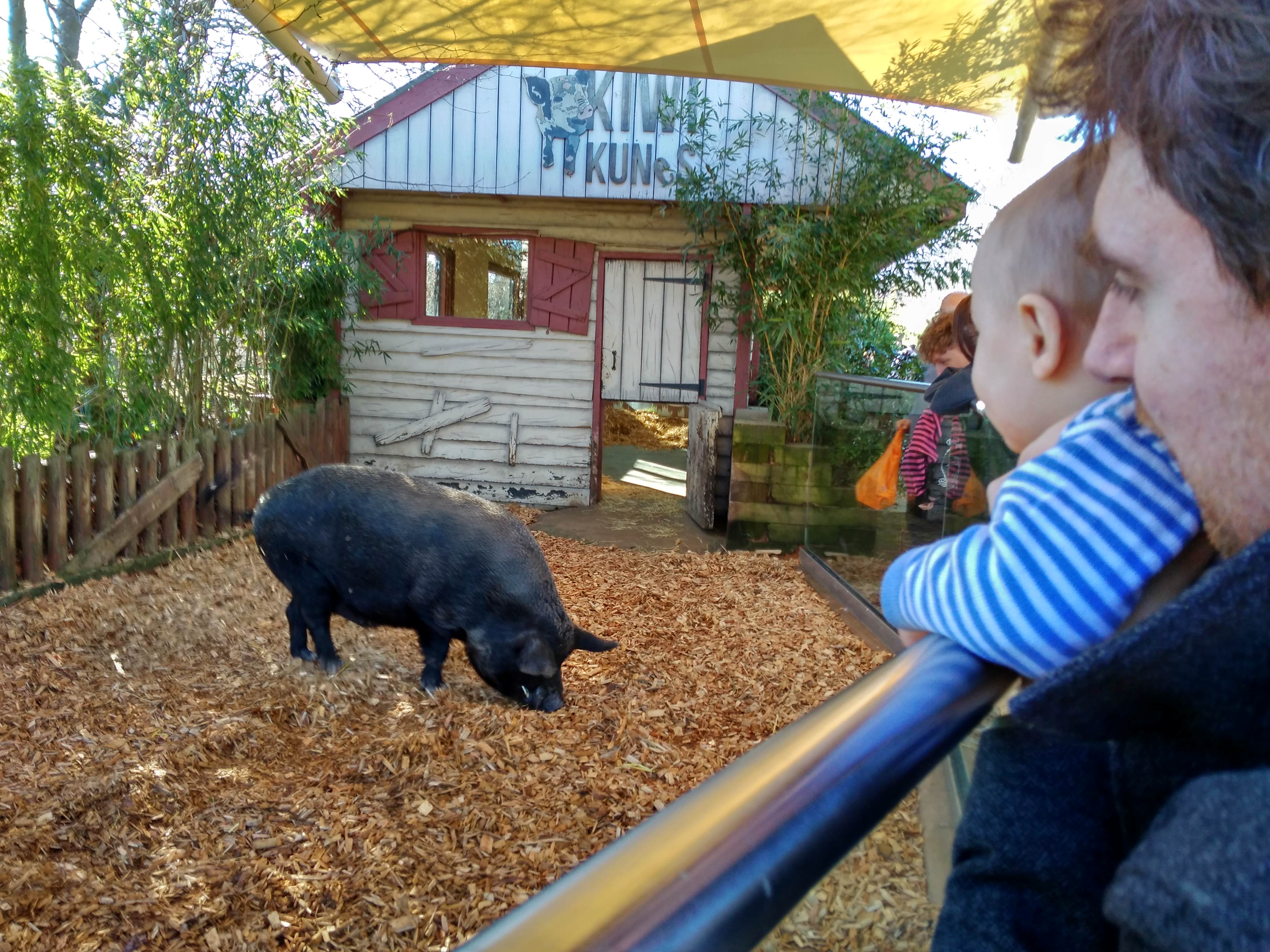
-Walk through Nature. Visit local parks and forests with the following goals in mind:
-Identify/describe plants, animals, environment: What are they called, how do they feel, what do they
look like? Kids can practice drawing or coloring in what they have seen.
-Introduce life cycles of plants, animals: For example, find an acorn, baby tree, big tree; or lily seed,
tiny shoot, flowering lily; or bird egg, baby bird, mommy bird (long-term activity requiring returning to same
location multiple times to see changes). Kids can draw what they see each time and link in a sequence.
-Discuss transitions of seasons: What does it feel like outside, what does it look like outside, what are
the animals doing? etc in the 4 seasons (long-term activity done throughout the year). Kids can draw pictures
or collect items for each season.
-Identify/describe different types of weather/natural events: For example, discuss sunny, rainy, windy,
cold, hot, humid, thunderstorm, foggy, earthquake, tornado, hurricane, etc. What do we wear in each type
of weather? What is safe and not safe to do in each type of weather?
Pros: Kids are naturally curious so enjoy the activity. No extra planning required as likely already going to or
through a park/forest. No associated costs. Kids can also practice drawing and coloring.
Cons: Long-term projects require patience from kids - they may forget what they saw the previous time.
Parents also have to keep track of drawing/objects for a long time.

-Play with Mirrors. Let kids look at themselves in a mirror. Babies will think the reflection
is another baby and try to interact by reaching out and smiling at the "other baby". Toddlers will
understand the reflection is their own and enjoy making faces at themselves. Both babies and toddlers
will be interested in watching sunbeams bounce off the mirror and around the room.
Pros: Cute activity that makes good pictures to keep! No set-up or clean-up. No associated cost.
Cons: Adult supervision required to make sure kid doesn't pull the mirror on themselves or throw anything
at the mirror.

-Play with Bubbles. Blow bubbles for the child to look at, crawl around in, walk/run through. Let
older toddlers blow their own bubbles with bubble wands (be sure to hold the wand or child will likely tip
bubble solution out). Some libraries have bubble sensory play as well, with bubble tubes that turn different
colors when you touch them.
Pros: Everyone seems to love bubbles. Do this bubble activity in the park for instant friends!
Cons: Child likely to dump out bubble solution, which will cause tears. Bubbles may get into child's eyes
as well, which might cause tears. Bubble solution can make floors slippery so be careful walking
around.
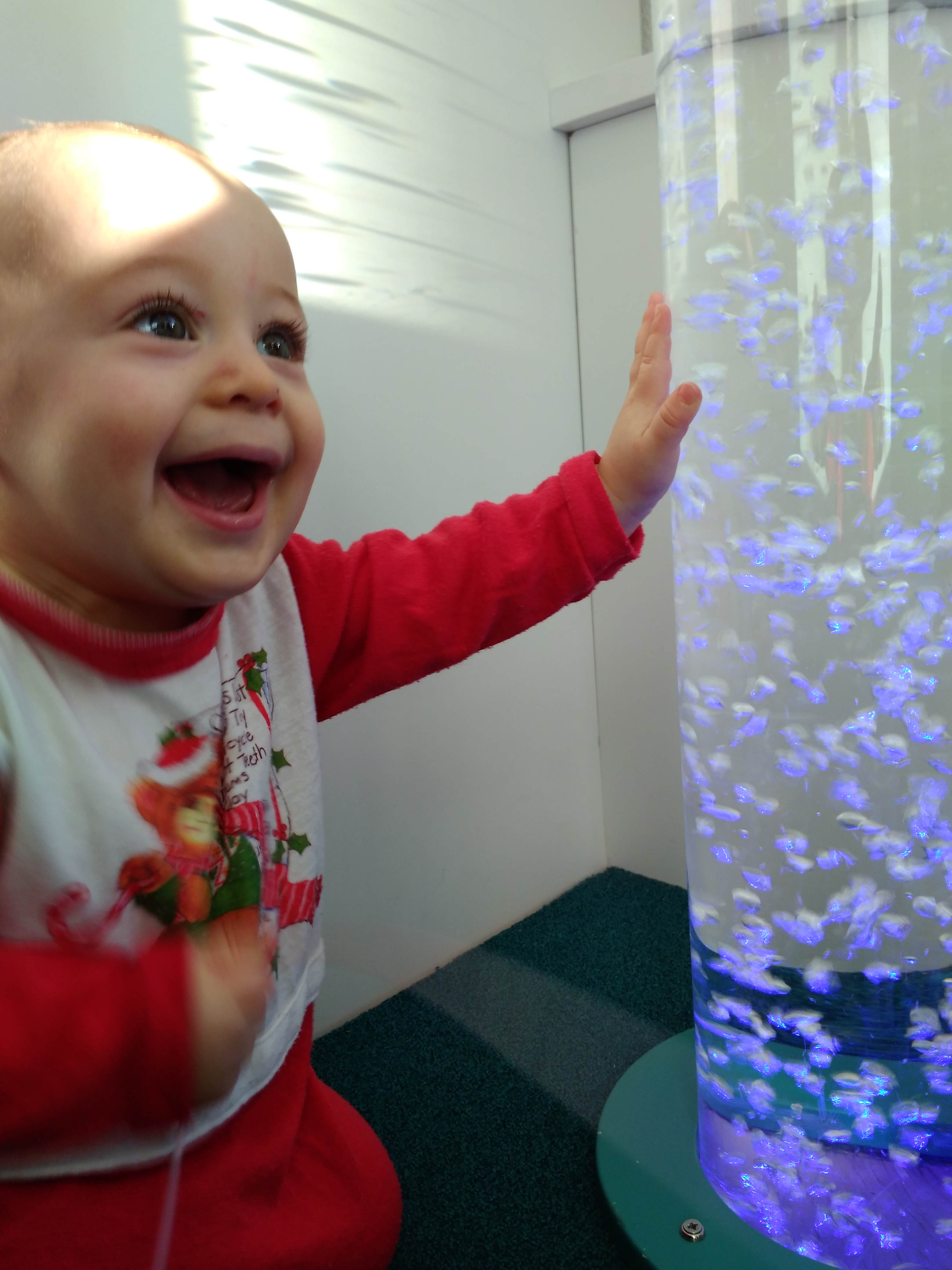
-Experiment with Shadows. Put different objects in front of a flashlight and have kid look at
shadows created on a wall. Bring object closer or further away from the light and talk about how
the resulting shadow changes. Let kids put their hands in front of the light to make shadows of their hands
as well. You can also trace the shadow onto a piece of paper for older toddlers.
Pros: No set-up or clean-up. No associated cost. Fun event for kid and adult to share.
Cons: Need a dark space for activity.

-Experiment with Colors. Put small amounts of different colors of paints into a ziploc freezer
bag. Push all of the air carefully out of the bag, and zip the bag closed. Then let the kid mash the paint around in the bag.
When the paint colors mix, they make new colors. Make sure the baby/toddler doesn't open the ziploc
bag!
Another option is to let kids mix colors of markers, crayons, or colored pencils. For example, coloring
yellow and red in the same location and seeing it appear orange.
Pros: Fun, quick activities. Likely no associated cost as probably already have markers, crayons, colored
pencils.
Cons: Need to buy paint if you don't already have it. Adult supervision required to ensure kids do
not color or paint anything.

-Colourblocks: TV Show from BBC. Animated Kids TV show about the names of colours, how colours are related to
each other, and what happens when you mix colours. There are currently 30 episodes available.
Pros: Entertaining show that teaches kids about colors. Catchy songs that show kids learning is fun. Watchable for
adults (not my favourite but it's ok!).
Cons: I suggest trying to limit kids' screentime. Need BBC subscription to watch.
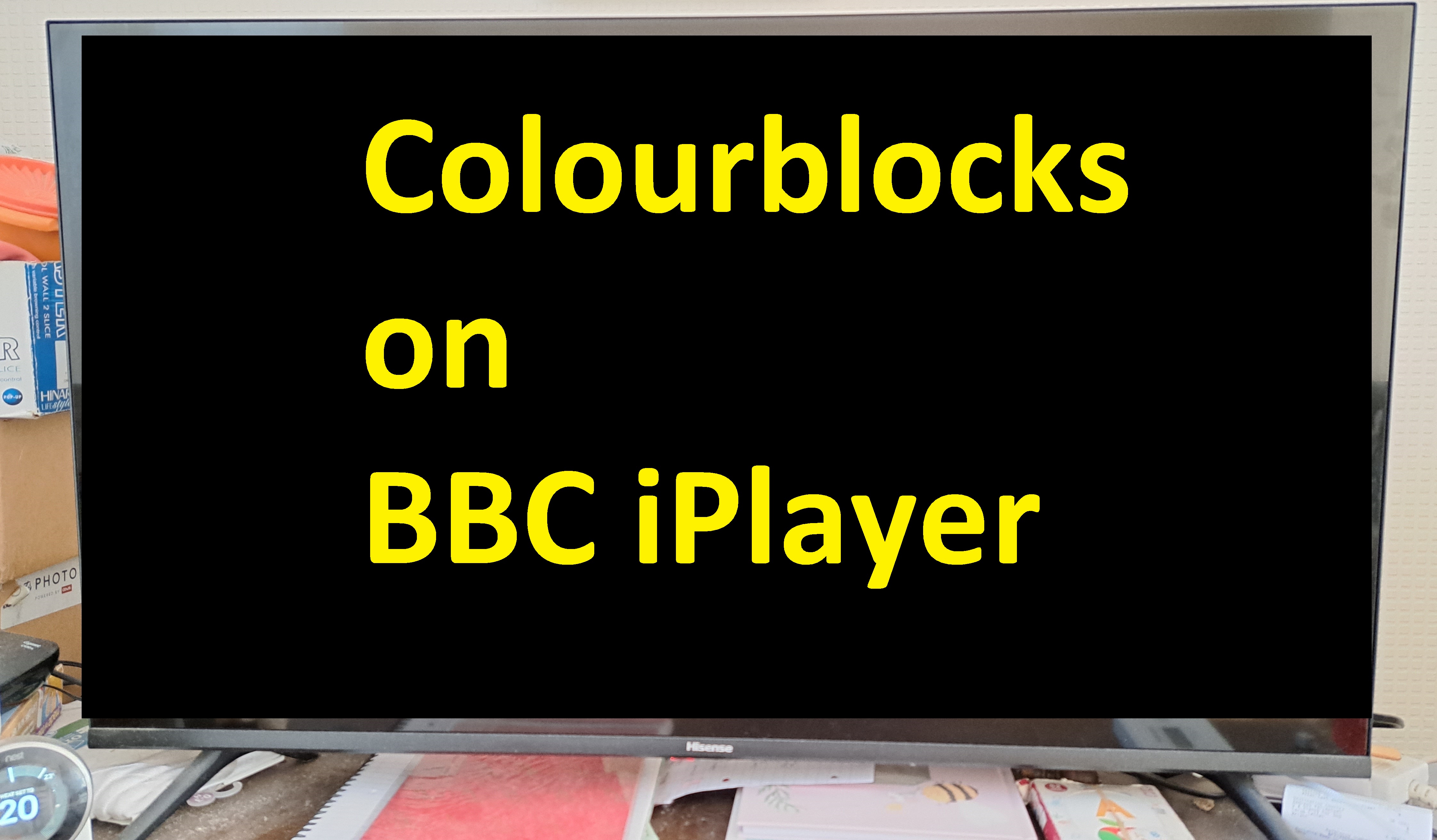
-Teeny Tiny Creatures: TV Show from BBC. Kids TV show with every episode focusing on a different animal.
There are currently 40 episodes available.
Pros: Engaging show that introduces a variety of animals. Kids will recognize some animals from local environment
but some animals will likely be new for kids. Show with real people and animals, not animations of animals!
Watchable for adults (not my favourite but it's ok!).
Cons: I suggest trying to limit kids' screentime. Need BBC subscription to watch.
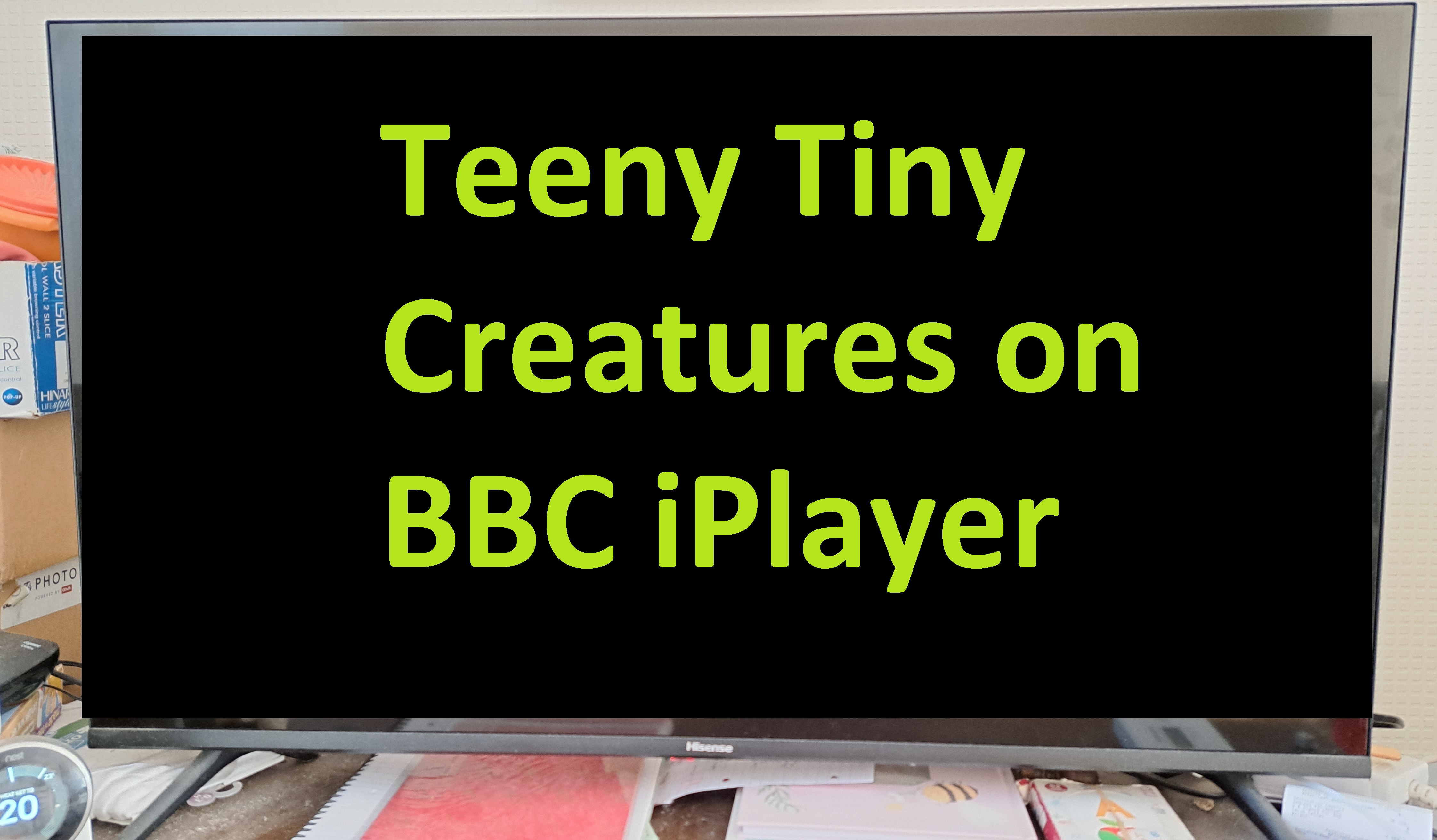
T: Technology
At this age, Technology focuses on both gross and fine motor skills as well as a familiarity with basic technology.
Some activities involve items commonly available in the home or visiting public locations, and so have
no associated cost. Some activities involve toys you would likely need to buy. These toys are easy to find
second-hand from charity shops or can be bought new.
-Explore and Build with Household Items. Sometimes called "Treasure Boxes". In this activity,
let the baby/toddler play with everyday objects from around the house. Items which make noise, have
different textures, or different colours are usually very popular. Kids also like to play with objects
they regularly see adults "play with"/use.
Pros: Can use different household items each time. No associated cost. Kids like playing with things
they see adults using.
Cons: Make sure not to use items which could hurt kids. Adult supervision required to ensure kids do not
hit themselves in head/poke themselves in the eye/push anything too far into their mouth.
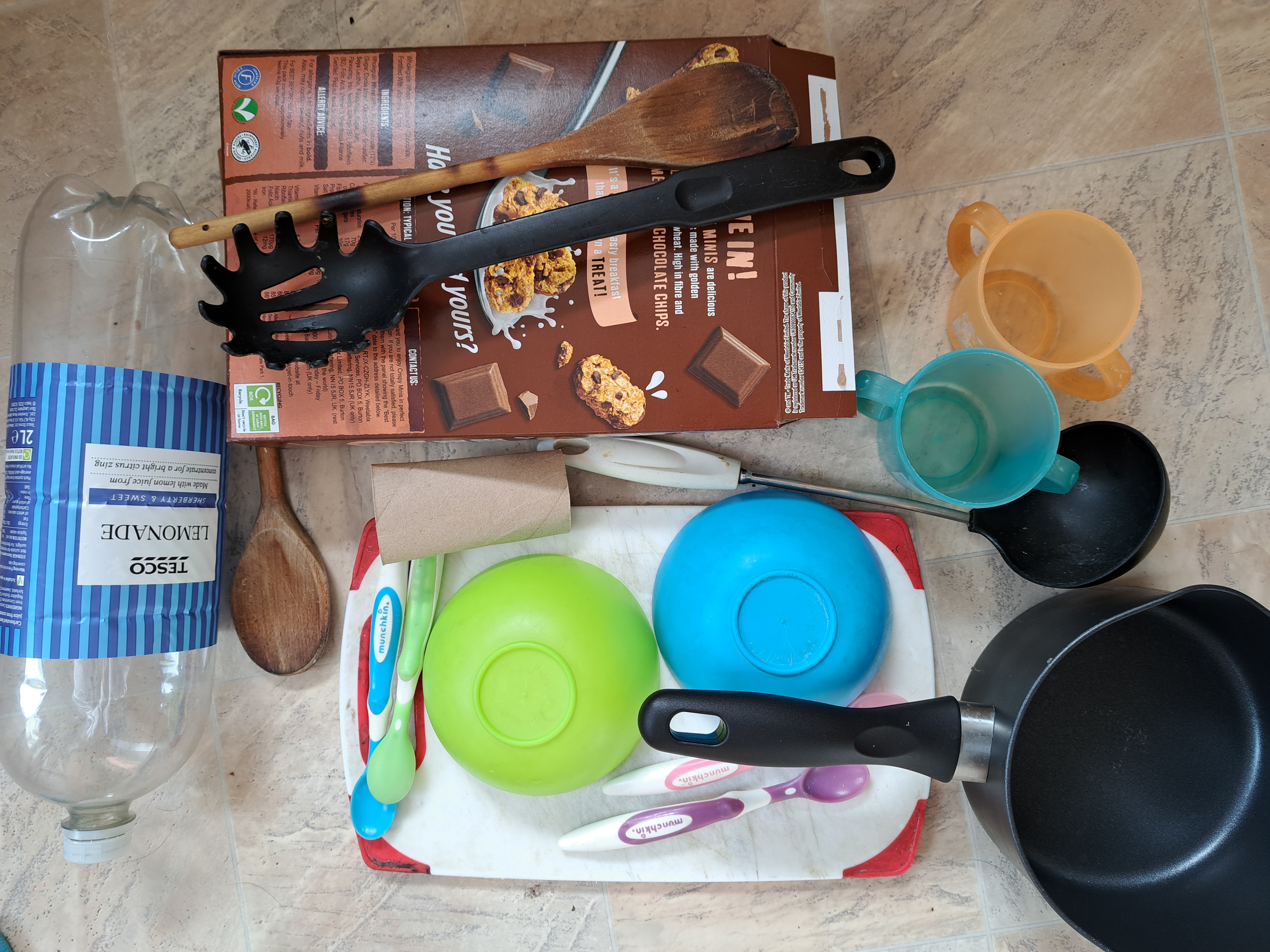
-Play with Sensory Balls.
Players: 1+
Recommended ages: 6+ months
Time to play: 5+ minutes
Paid: £8 from Amazon
We were given two sets of Sensory Balls: one from Bright Starts, and
I can't remember the brand of the other. Some balls make noise. Others have pieces inside that spin. Others
have clunky penguins or turtles that move around. Some have tiny balls in a maze. The sensory balls are
good for when babies are learning to pick up objects. I think toddlers usually roll them back and forth
as a game, but my kids never did this. My kids skipped from looking-at-them phase to throwing-them-around
phase!
Pros: Babies/toddlers can play largely by themselves (although don't leave a 6-month old baby alone!).
Balls do a variety of different things to entertain kids.
Cons: May not hold babies' attention for long. Toddlers can throw them surprisingly hard. I have
rarely seen them second-hand at charity shops, so they would likely need to be bought new.

-Play with Toy Vehicles. Planes. Trains. Automobiles. Helicopters. Fire trucks. Ambulances. Dump
trucks. Monster trucks. Our kids LOVE anything with wheels, especially if you can pull them back
and then the toy goes forward on its own.
Pros: Can find in variety of themes. Very easy to find second-hand online or from charity shops.
Cons: Flywheel pull-back-and-go function can break easily. Vehicles are easy to step on
and end up everywhere in the house.

-Play with
Construction Toolbox.
Players: 1+
Recommended ages: 3+ years
Time to play: 10+ minutes
Paid: £20 online
The Little Dutch wooden toolbox was a Christmas present from a family member. Our kids like having
their own version of the tools adults use. They learned the names of the tools, tried to hammer
everything (even things not from the toolbox) and eventually, at 4 years old, learned to properly use the screwdriver.
Pros: Chunky pieces are easy for small hands to grasp. This wooden toolbox is very sturdy. It has
withstood a lot of use from our children - while many plastic toolboxes have fallen apart.
Cons: Kids will try to hammer everything in the house: TV, windows, each other.... Expensive toy.
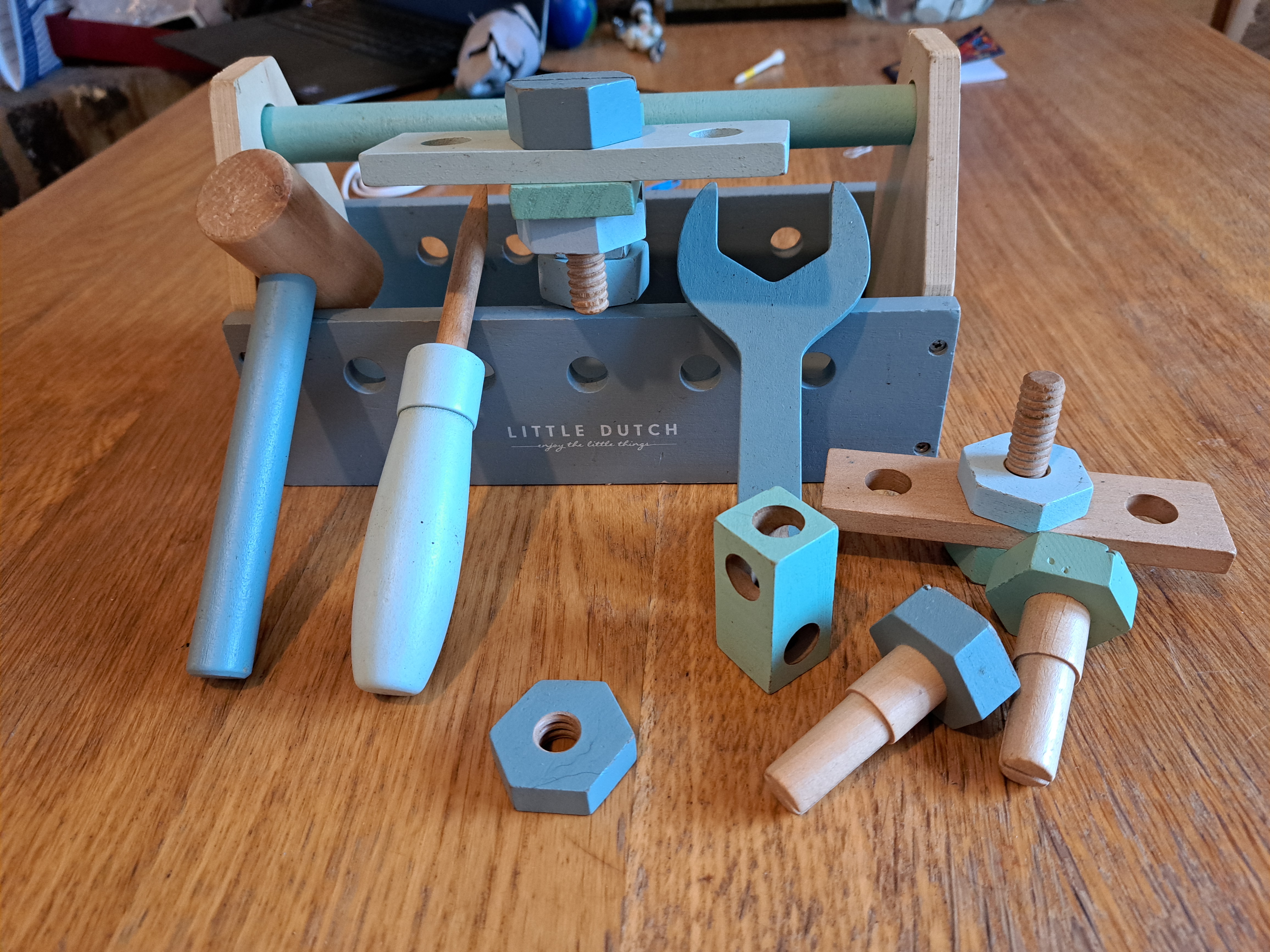
-Visit Local Bus and Train Stations (and Airport if Nearby). Visit local transportation stations
to familiarize kids with transportation modes and environments. Kids can also practice counting the number
of wheels on the bus or the number of carriages on the train, etc. If possible, ride the train
or bus for a few stops so kids can feel comfortable on the bus/train, understand they need to sit down,
know where to buy tickets, how to get the bus to stop, etc.
Pros: Understanding transportation modes is a useful skill to make kids feel comfortable in their
environment. Visiting stations is free and can be done nearly any time of day. No planning is needed, and
there is likely very little travel required to reach local station. Kids are generally very excited
to see buses, trains, and trains.
Cons: Close adult supervision is required to make sure kids are safe around traffic. Riding bus/train
is not free.

E: Engineering
At this age, Engineering focuses on creatively building structures. These activities mostly involve
items which need to be bought, although many items can be easily purchased from charity shops or
second-hand sales.
-Build with
"Duplo" from Lego.
Players: 1+
Recommended ages: 1.5+ years
Time to play: 10+ minutes
Paid: £2 from charity shop
Babies will likely only pick up and put down/throw Duplo pieces rather than build anything. Older toddlers will be
able to build simple structures. Both of these ways of playing with Duplo practice hand-eye coordination
and motor skills.
Pros: Duplo grows with the kids, allowing for more complex play as kids age. Activity allows for creativity and has excellent replayability.
Duplo is difficult to break. It does not matter if Duplo gets wet, dirty, or lost (or gnawed by a dog in our case!). Minimal adult
supervision is required. Duplo is also fun for adults!
Cons: Duplo pieces get spread throughout the house and hurt when stepped on.

-Build with
"Stickle Bricks" from Hasbro.
Players: 1+
Recommended ages: 1.5+ years
Time to play: 10+ minutes
Paid: £10 from toy shop
Stickle Bricks are different-shaped plastic pieces that have little plastic fingers along their edges. The fingers can
be pushed together to hold the pieces together. As babies, our kids used Stickle Bricks as teethers (as did the dog -
notice the bite marks!). As older toddlers, our kids started making objects with the Stickle Bricks. Frequently,
they used the Stickle Bricks alongside the Duplo.
Pros: Different shapes allow kids to be creative. Durable pieces, difficult to break. Good replayability. Pieces aren't
damaged if they get wet. Kids can still build if a few pieces get lost.
Cons: Stickle Bricks were the hardest building toy to clean. Personally, I think that Stickle Bricks
have fewer opportunities to be creative than Duplo. If space/cost are
issues, I'd suggest Duplo - but both have their advantages.
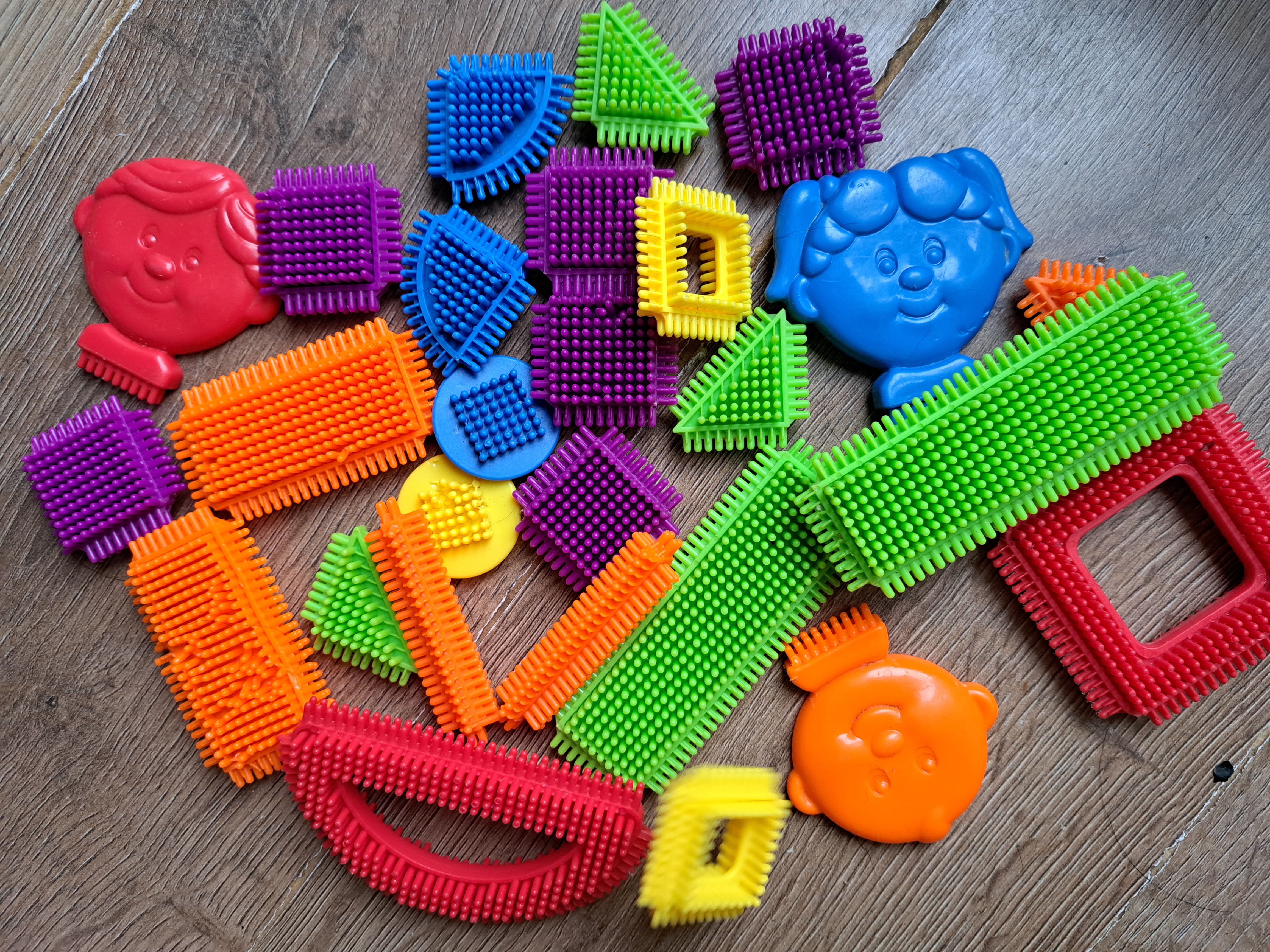
-Build with
"Magna-Qubix" from Magna-Tiles.
Players: 1+
Recommended ages: 3+ years
Time to play: 10+ minutes
Paid: £25 from toy shop for 29 piece set
Magna-Qubix are 3D shapes (cubes, pyramids, half-cylinders, etc) as opposed to Magna-Tiles which are flat. We got
this kit when the oldest was almost 3 years old. He liked building simple 3-piece shapes then. Now at 5 years old,
he builds many intricate designs with it - as does the 4 year old. This is a toy for older toddlers that can grow
with the child.
Pros: Sturdy pieces that are difficult to break. Big enough for small hands to grasp. Kids like feeling magnets
snap the pieces together and back apart again. Excellent replayability. Easy for children to understand and
play with minimal adult supervision. Also fun for adults!
Cons: The blocks end up all over the house and really hurt when you step on them! Fairly expensive kit for not many
pieces. I've never seen them second-hand or in charity shops so likely to need to be a new purchase.
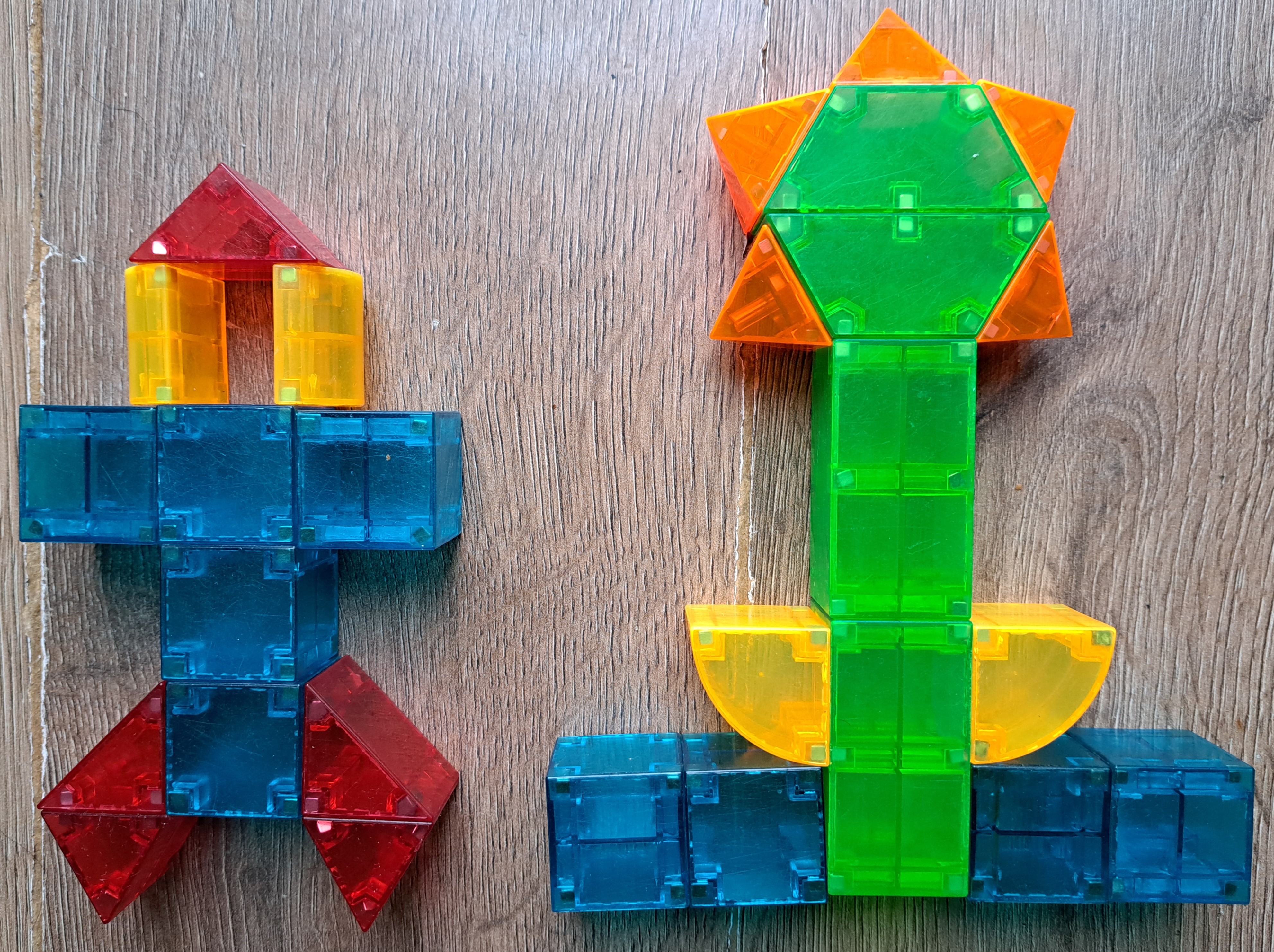
-Build with
"Magnetic Construction Kit" from Magformers.
Players: 1+
Recommended ages: 3+ years
Time to play: 10+ minutes
Paid: £30 from toy shop for 30-piece set
Stick square and triangular magnetic pieces together to create 2D or 3D structures. Babies like swinging
the pieces and feeling the magnets attract and repel each other. Toddlers (and older kids) like building
houses, spaceships, fences, train tracks, etc.
Pros: Fosters creativity and understanding of how triangles and squares can fit together. Good replayability.
Easy for children to understand and play with minimal adult supervision.
Cons: Fairly expensive kit. Personally, I think that Magna-Qubix are more fun and allow for more creative
builds. I only rarely see these toys for second-hand sale so they would likely need to be purchased new.
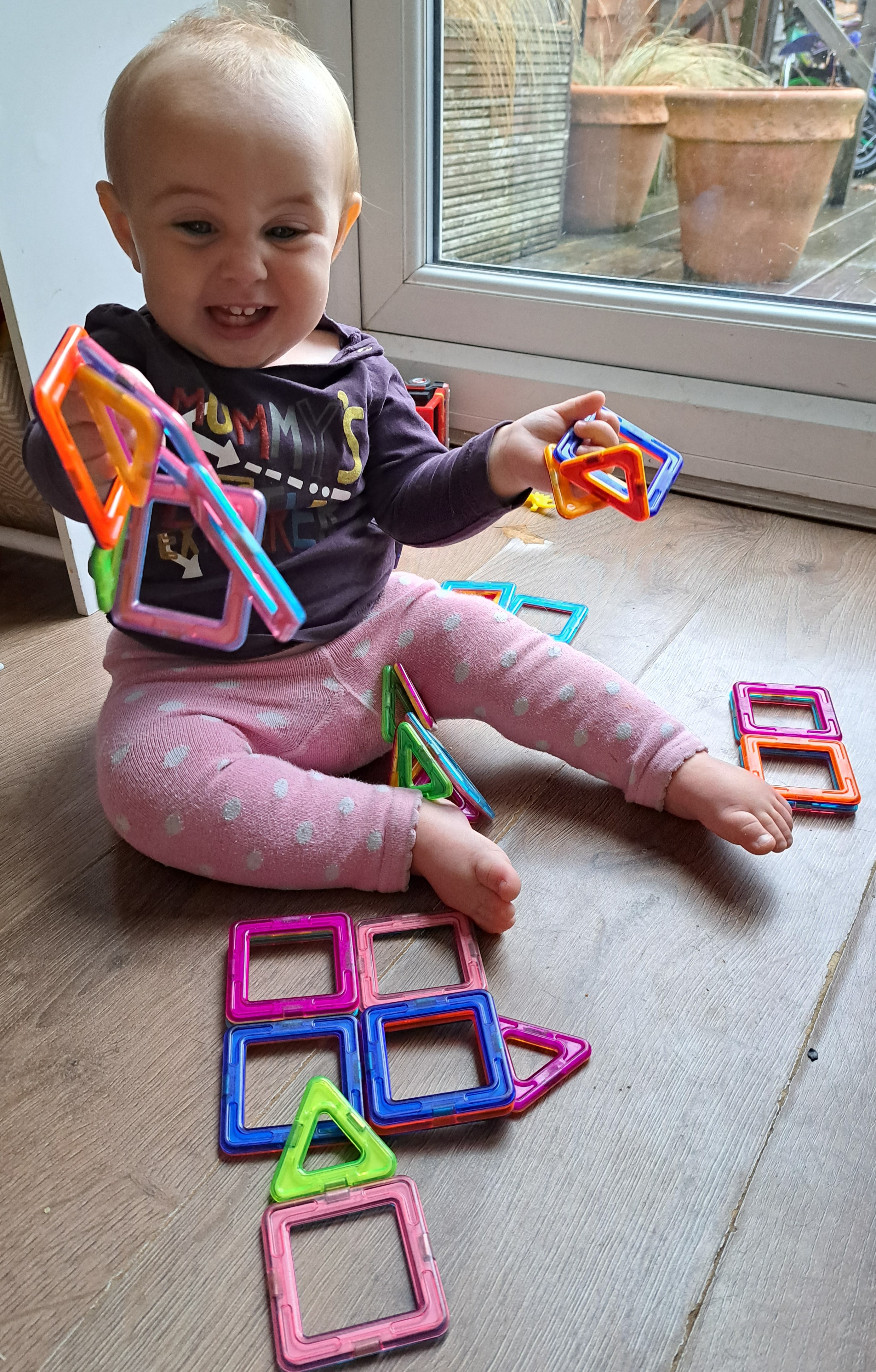
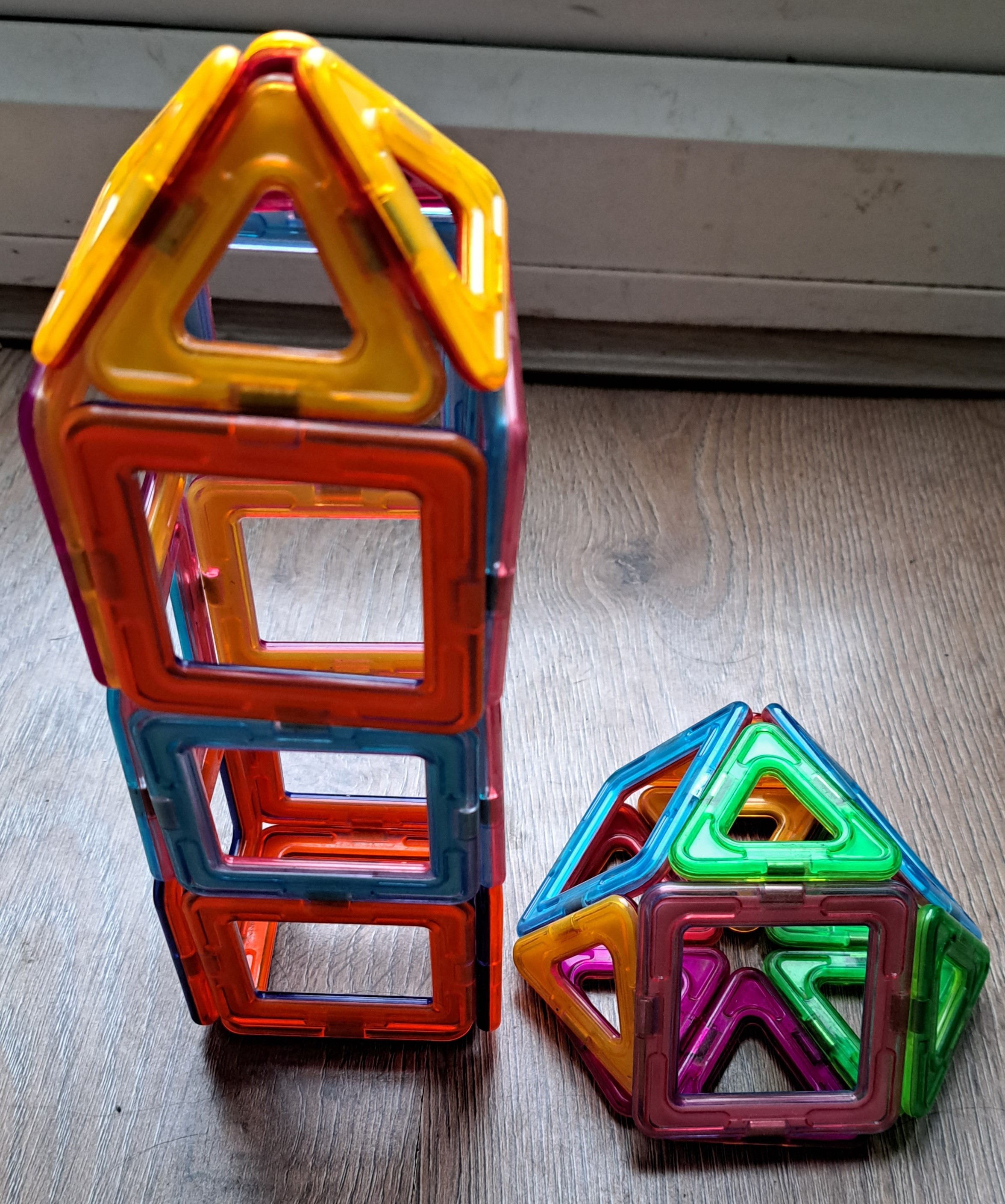
-Play with
Play-Doh.
Players: 1+
Recommended ages: 2+ years
Time to play: 10+ minutes
Paid: £10 from toy shop for 18 tubs
Shape Play-Doh to make your own creations. Squish back together to build again. Can also make your
own play-dough by mixing cornstarch, baking soda, and water (we added red cabbage juice to make ours pink and
then stored it in an empty Haribo container).
Pros: Fosters creativity and can be used multiple times. Free activity if you make your own play-dough. Homemade
play-dough can be cooked in the oven to make a nice keepsake (good for making handprint casts!).
Cons: Play-Doh easily picks up dog hair and dust so can get dirty easily. If two colors of Play-Doh are mixed, it
is nearly impossible to split the two colors apart again. Kids generally try to eat Play-Doh. Second-hand Play-Doh
is hard to find so Play-Doh will likely need to be bought new (or home-made).
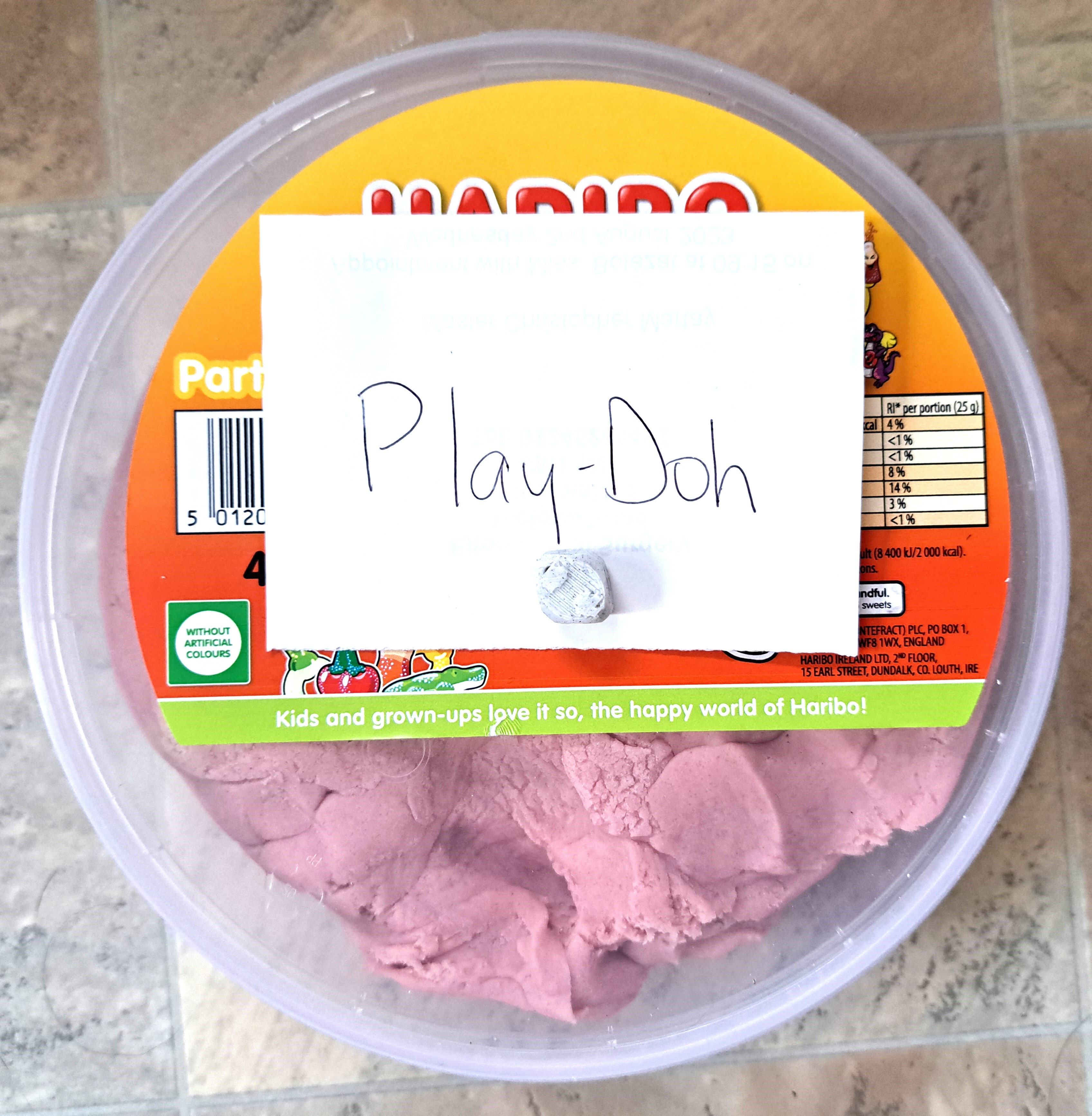
-Play with Sensory Busy Boards.
Players: 1+
Recommended ages: 1+ years
Time to play: 10+ minutes
Paid: Home-made for £50 (with leftovers for more boards)
Busy Boards can be bought from stores. We make our own Busy Board so we could put exactly what we wanted
on it. We added different types of light switches, door locks, and noisy toys that we either already had at
home or bought from stores. The kids have gone through phases of really liking the toy, and it's still
being used 3 years later, now by all 3 kids!
Pros: We built a custom-made board - which let the adults practice their building skills also! Unique
birthday present with exactly what we wanted!
Cons: Making the board took a few hours. Expensive board, especially if kids end up not liking it.
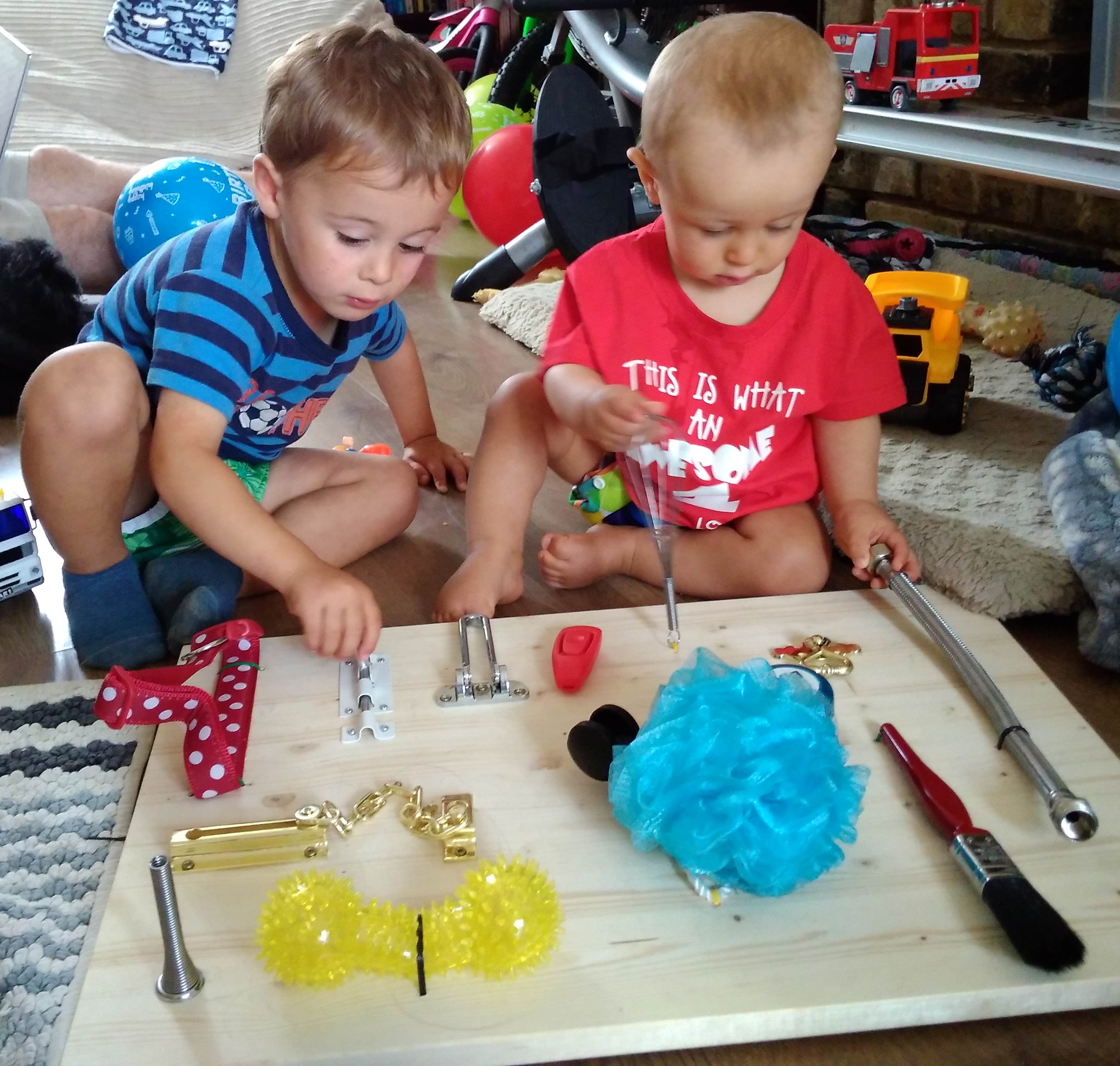
-Play with Ramps. Build ramps with materials you already have around the house. Let toddlers
decide what to use for the ramp, how to set up the ramp, what to roll/push down the ramp, etc. Then you can
talk about why different things roll/slide down the ramp at different speeds - and how the slope of the
ramp affects the moving object's speed. For added fun, kids can decorate the ramp also.
Pros: Kids get to drive the activity: picking materials and construction method. Builds kids'
intuition of how things move. No associated cost.
Cons: Can be a fairly short activity.
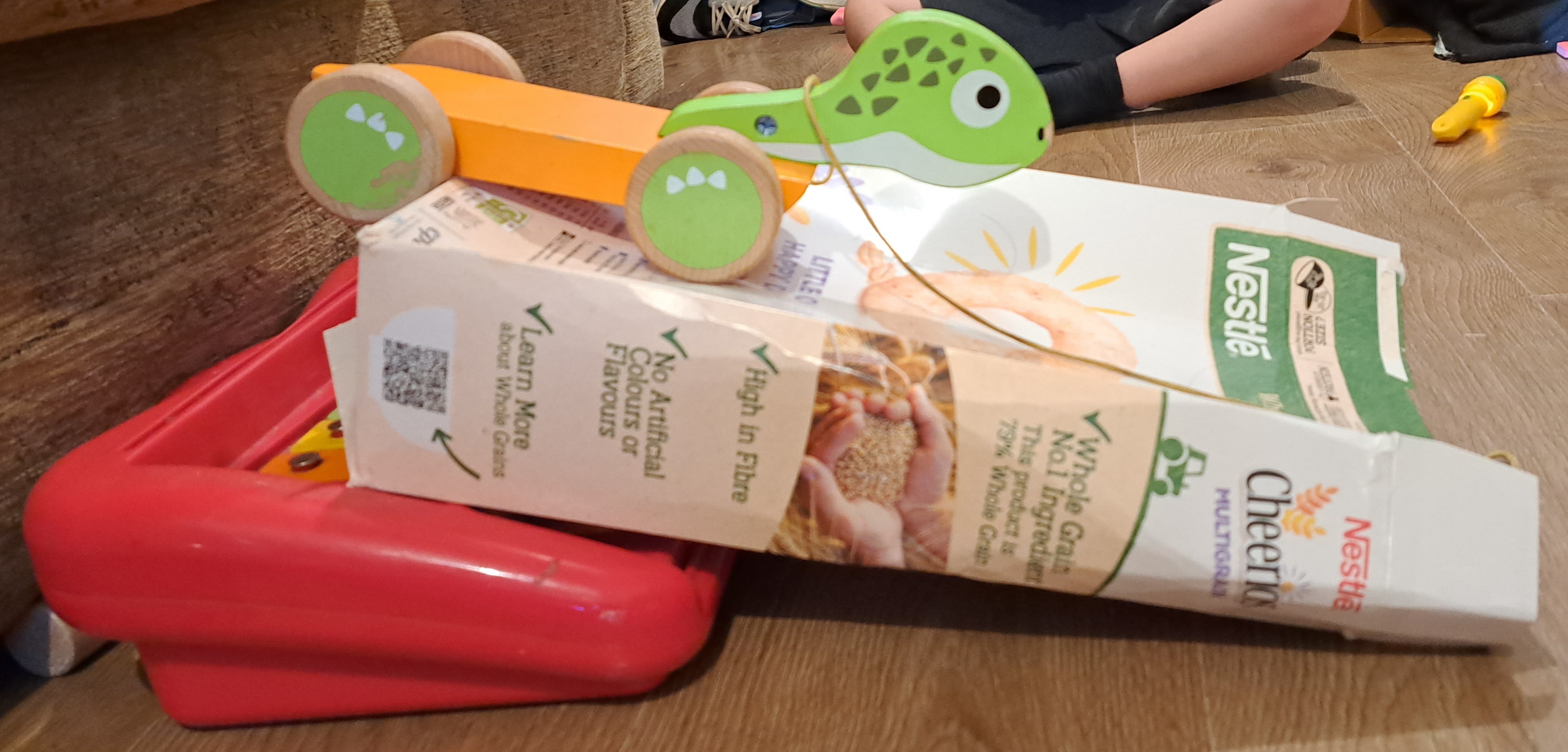
-The Stinky & Dirty Show: TV Show on Amazon Prime. Animated kids TV show about a garbage truck and backhoe loader.
In each episode, the pair encounter a problem, which they solve by asking "What If...." and creatively thinking of
potential solutions. There are currently 39 episodes available.
Pros: Fun for both kids and adults to watch. Kids learn about creative problem solving without realizing it.
Many episodes available, and easily re-watchable.
Cons: I suggest trying to limit kids' screentime. Need Amazon Prime subscription to watch.

M: Mathematics
At this age, Mathematics focuses on counting to 10 and grouping items based on characteristics such as size, colour,
or shapes. These activities can be done with items already available within the house and have no associated costs.
-Practice Counting Objects (Up to 10).
Players: 1+
Recommended ages: 6+ months
Time to play: 5+ minutes
Paid: £11 from The Entertainer
Someone gave us Early Learning Centre's "Stacking Cups" as a present. We use them both to practice stacking
and to practice recognizing and counting numbers to 10.
There are many other ways to practice counting as well.
We enjoy reading/singing Counting Nursery Rhymes, such as "5 Little Monkeys", "5 Little Ducks", and
"Once I Caught a Fish Alive". Library Rhyme Times are perfect to join to read/sing nursery rhymes. We
also look for numbers as we walk around town (street numbers, prices, amounts of food, etc) to practice
numbers.
Pros: Very easy to practice recognizing and counting numbers in everyday life - no need to buy anything.
If you want to buy something, many options are easily and cheaply available from charity shops and
second-hand sales.
Cons: None.
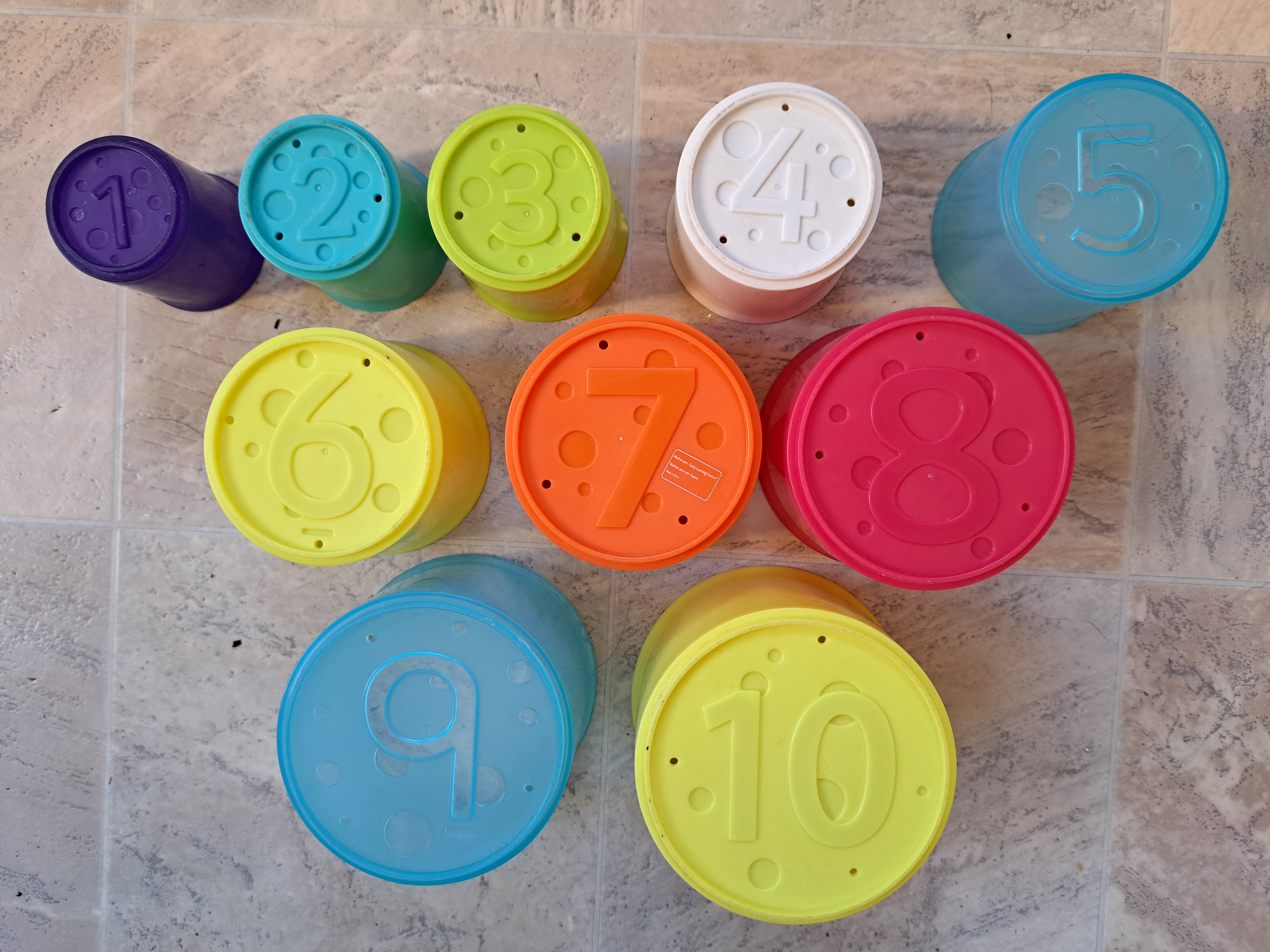
-Group Toys/Items Based on Characteristics. Sort items based on color, size, number, any number
of characteristics. I suggest chosing toys/items that the child is interested in. For example, our 1-year
old is currently very interested in shoes so we sorted the shoes below according to size. We could also then sort
the same shoes into velcro vs laces - or into shoes that have vs do not have a back tab, etc.
Pros: Minimal preparation and clean-up time. Great replayability with nearly limitless characteristics to group based on.
Fun way to practice numbers, colors, etc. No associated cost.
Cons: None.

-Numberblocks: TV Show from BBC. Animated kids TV show. Early episodes focus on numbers 1-5. Middle episodes focus on
numbers up to 100. Later episodes focus on odd vs even numbers and multiplication.
Pros: Catchy songs and cute animations make show fun for both kids and adults. Kids learning numbers in a fun environment.
Cons: I suggest trying to limit kids' screentime. Need BBC subscription to watch.
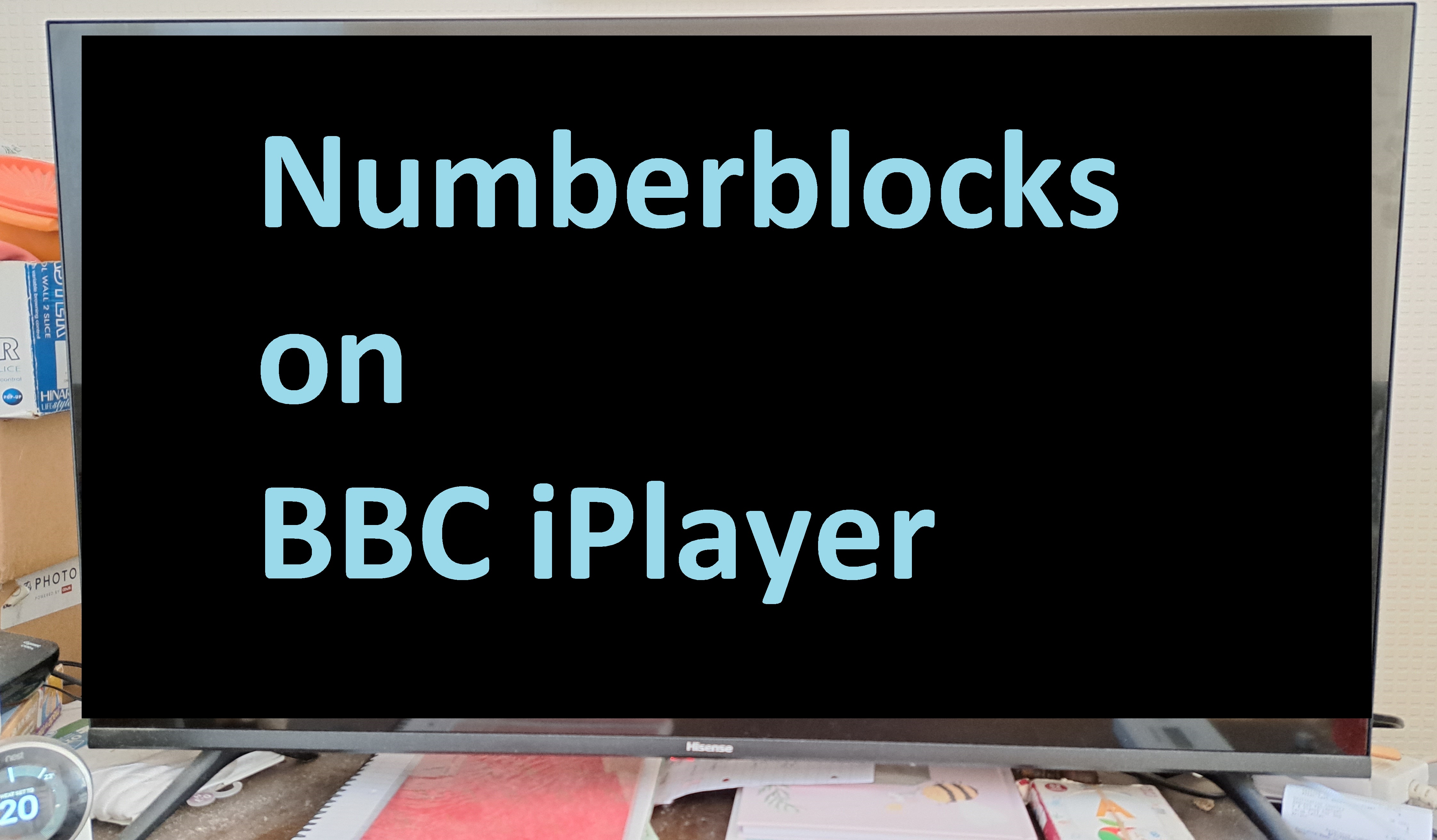
This website was created in October 2023 based on what was available at the time and what my children have enjoyed. There will doubtless be other games and activities you have also enjoyed. Please leave comments on the YouTube video above if there is something you think should be added to the list. Thank you for reading!
Other Articles:
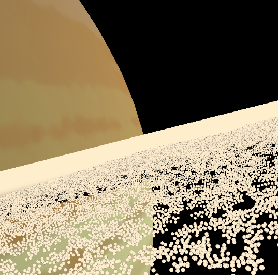
|
Saturn's ringsA simulation of Saturn's rings --- a few thousand particles are simulated, in a repeating tiled region. You use the mouse and keys to fly in it. |

|
Moon FormationA Kotlin N-Body code, and lots of animations of the collision between Earth and a hypothetical Theia that people think created the moon. |
How SpaceX land first stage boostersThe algorithms that SpaceX (probably) use to control their first stage boosters. Several animations. |

|